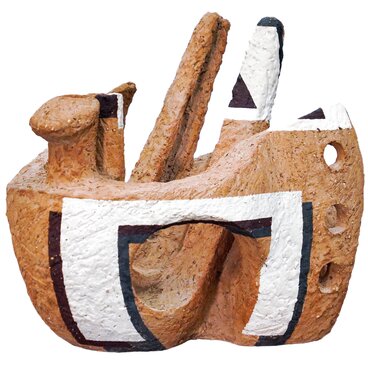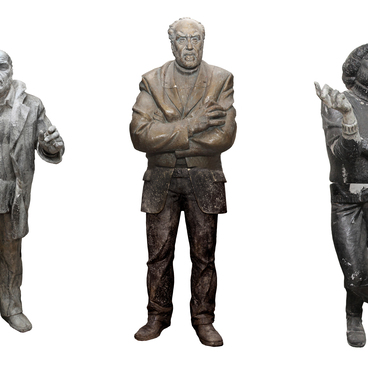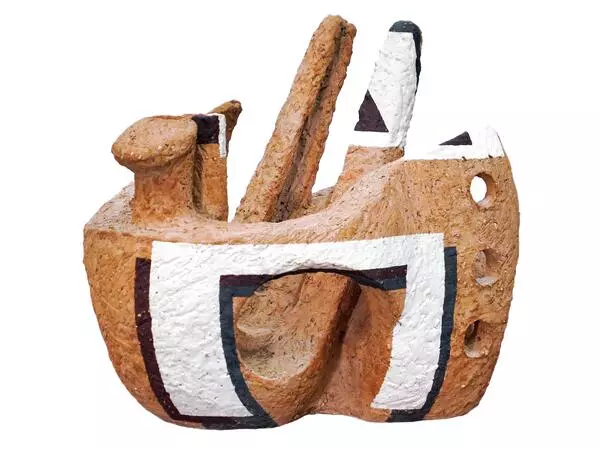The Ural artist Yuri Krylov created about 400 sculptures, from small figures to large-scale works. He worked with a variety of media such as wood, stone, metal, and clay. He used subjects and themes from history, personal experience, and ancient and biblical stories. The sculptural composition “Saint George the Victorious” belongs to a series of images of Christian saints in the sculptor’s interpretation.
The image of St. George is one of the most popular in European and Russian cultures. It served as a basis for a whole new cultural layer, which was characterized by various means of expression —myths and legends, pictorial iconography (frescoes, icons, paintings, sculptures, coats of arms, banknotes, etc.), hagiographies, and secular literature. The image of the saint has been extremely popular since early Christianity. In Russian culture, he was glorified primarily in icon painting and in the names of churches. The profile of St. George was placed on seals and coins. His image is featured on the coats of arms of Russia and Moscow, and on the St. George Cross, the highest award for military valor. There are five monuments dedicated to Saint George the Victorious in Moscow alone. Other cities such as Nizhny Novgorod, Ryazan, Krasnodar, Yakutsk, and Sevastopol also paid their monumentary tribute to the saint.
For his sculpture, Krylov used one of the most common iconographic types of the saint — the “St. George and the Miracle of the Serpent”, where George the Victorious is depicted on horseback, striking a huge serpent or dragon with a spear. The composition is made in the techniques of chamotte and stoving enamel. The sculptor used them to create new shapes, formed by simplifying the plasticity of recognizable contours to transform them into certain archetypes. Thus, Krylov offered a reinterpretation of the classic biblical story by giving it a new look. The sculptor restrained his choice of details and colors, which are limited to the natural shades of fired clay and accents of white and dark brown. This was done to emphasize the dynamics of the shapes. The combination of elements of the famous plot and its reinterpretation is balanced, and the image of a victorious hero on a horse, trampling a snake, emerges from semi-abstract forms that resemble a primitive and rough folk clay toy.
The image of St. George is one of the most popular in European and Russian cultures. It served as a basis for a whole new cultural layer, which was characterized by various means of expression —myths and legends, pictorial iconography (frescoes, icons, paintings, sculptures, coats of arms, banknotes, etc.), hagiographies, and secular literature. The image of the saint has been extremely popular since early Christianity. In Russian culture, he was glorified primarily in icon painting and in the names of churches. The profile of St. George was placed on seals and coins. His image is featured on the coats of arms of Russia and Moscow, and on the St. George Cross, the highest award for military valor. There are five monuments dedicated to Saint George the Victorious in Moscow alone. Other cities such as Nizhny Novgorod, Ryazan, Krasnodar, Yakutsk, and Sevastopol also paid their monumentary tribute to the saint.
For his sculpture, Krylov used one of the most common iconographic types of the saint — the “St. George and the Miracle of the Serpent”, where George the Victorious is depicted on horseback, striking a huge serpent or dragon with a spear. The composition is made in the techniques of chamotte and stoving enamel. The sculptor used them to create new shapes, formed by simplifying the plasticity of recognizable contours to transform them into certain archetypes. Thus, Krylov offered a reinterpretation of the classic biblical story by giving it a new look. The sculptor restrained his choice of details and colors, which are limited to the natural shades of fired clay and accents of white and dark brown. This was done to emphasize the dynamics of the shapes. The combination of elements of the famous plot and its reinterpretation is balanced, and the image of a victorious hero on a horse, trampling a snake, emerges from semi-abstract forms that resemble a primitive and rough folk clay toy.




